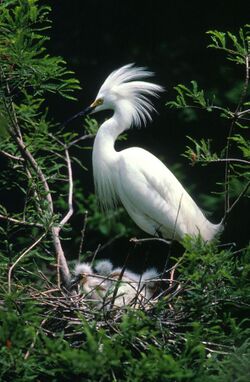List of birds of North America (Pelecaniformes)
Topic: Biology
 From HandWiki - Reading time: 2 min
From HandWiki - Reading time: 2 min
The birds listed below all belong to the biological order Pelecaniformes, and are native to North America.
Pelicans
Order: Pelecaniformes Family: Pelecanidae
Pelicans are very large water birds with a distinctive pouch under their beak. Like other birds in the order Pelecaniformes, they have four webbed toes.
- American white pelican, Pelecanus erythrorhynchos LC
- Brown pelican, Pelecanus occidentalis LC
Bitterns, herons and egrets
Order: Pelecaniformes Family: Ardeidae
The family Ardeidae contains the herons, egrets and bitterns. Herons and egrets are medium to large wading birds with long necks and legs. Bitterns tend to be shorter necked and more secretive. Members of Ardeidae fly with their necks retracted, unlike other long-necked birds such as storks, ibises and spoonbills.
- Agami heron, Agamia agami VU
- American bittern, Botaurus lentiginosus LC
- Bare-throated tiger heron, Tigrisoma mexicanum LC
- Black-crowned night heron, Nycticorax nycticorax LC
- Boat-billed heron, Cochlearius cochlearius LC
- Capped heron, Pilherodius pileatus LC
- Cattle egret, Bubulcus ibis LC
- Chinese egret, Egretta eulophotes (A) VU Template:ESA status
- Chinese pond heron, Ardeola bacchus (A) LC
- Cocoi heron, Ardea cocoi LC
- Fasciated tiger heron, Tigrisoma fasciatum LC
- Gray heron, Ardea cinerea (A) LC
- Great blue heron, Ardea herodias LC
- Great egret, Ardea alba LC
- Green heron, Butorides virescens LC
- Intermediate egret, Mesophoyx intermedia (A) LC
- Least bittern, Ixobrychus exilis LC
- Little bittern, Ixobrychus minutus (A) LC
- Little blue heron, Egretta caerulea LC
- Little egret, Egretta garzetta (C) LC
- Pinnated bittern, Botaurus pinnatus LC
- Purple heron, Ardea purpurea (A) LC
- Reddish egret, Egretta rufescens NT
- Snowy egret, Egretta thula LC
- Striated heron, Butorides striata LC
- Tricolored heron, Egretta tricolor LC
- Western reef heron, Egretta gularis (A) LC
- Yellow bittern, Ixobrychus sinensis (A) LC
- Yellow-crowned night heron, Nyctanassa violacea LC
Ibises and spoonbills
Order: Pelecaniformes Family: Threskiornithidae
Members of this family have long, broad wings, are strong fliers and, rather surprisingly, given their size and weight, very capable soarers. The body tends to be elongated, the neck more so, with rather long legs. The bill is also long, decurved in the case of the ibises, straight and distinctively flattened in the spoonbills.
- American white ibis, Eudocimus albus LC
- Buff-necked ibis, Theristicus caudatus (A) LC
- Eurasian spoonbill, Platalea leucorodia (A) LC
- Glossy ibis, Plegadis falcinellus LC
- Green ibis, Mesembrinibis cayennensis LC
- Roseate spoonbill, Platalea ajaja LC
- Scarlet ibis, Eudocimus ruber LC
- White-faced ibis, Plegadis chihi LC
 KSF
KSF


